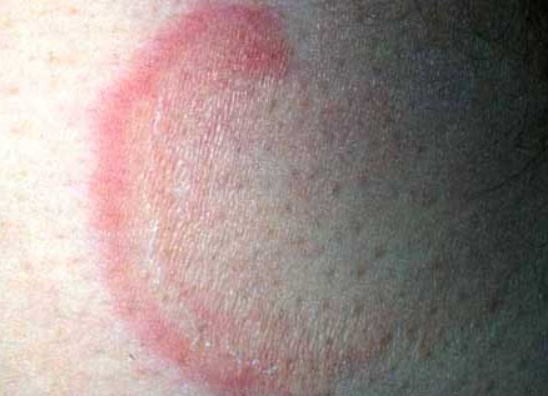Erythema annulare centrifugum (EAC) is a chronic, reactive phenomenon of the skin that presents with arcuate or annular, erythematous patches or thin plaques, often with scaling. ICD-10 code: L53.1
The prevalence of EAC is approximately one case per 2000 primary dermatology consultations. The condition is more common in middle-aged women, but it can occur at any age, starting from infancy.
In most cases, the etiology of the disease remains unclear and it is generally considered to be a reactive process. The disease is associated with various infections, including dermatophytes and other fungi such as Candida, as well as viruses (Epstein-Barr virus, poxvirus, HIV, varicella), parasites and ectoparasites (pubic lice), bacteria (Pseudomonas). Some foods and medications (cimetidine, rituximab, salicylate, ustekinumab, diuretics, nonsteroidal anti-inflammatory drugs, antimalarials, amitriptyline, sodium thiomalate, amitriptyline, etizolam) are considered causal factors. Associations with conditions such as Crohn's disease, pregnancy, autoimmune endocrinopathies, hypereosinophilic syndrome, sinusitis, and lupus erythematosus have been reported in the literature. In most cases, however, the cause of the disease cannot be identified.The disease is characterized by a chronic course. Initially, small pinkish infiltrated papules appear, which slowly increase in size at the periphery, eventually forming circular lesions with central clearing. The growth of the lesions is variable and can reach a diameter of 6-8 cm within 2 weeks. Progression is not always uniform, resulting in arcuate eruptions. Lesions may be solitary, but more commonly multiple. The peripheral margin is slightly flattened and barely palpable, smooth or slightly scaly, occasionally with vesiculation at the margin. The eruptions are accompanied by itching, which is rarely severe.
Any part of the skin may be affected, but the trunk is more commonly involved (73%), followed by the lower extremities (55%), upper extremities (32%), and less commonly the face and neck (14%). Each lesion may persist for several days, more often for weeks, or develop slowly over several months. New elements appear in the background and the process may continue periodically for several years.
Atypical variants of erythema annulare centrifugum include:
Squamous form of erythema annulare centrifugum in which there is scaling at the outer edge of the lesions in the form of a thin white border.
Vesicular form of erythema annulare centrifugum, characterized by the occasional appearance of rapidly fading vesicles at the edges of the eruptive elements.
- Ringworm
- Chronic urticaria
- Granuloma annulare
- Erythema multiforme
- Tuberculoid type of leprosy
- Dermatitis Herpetiformis
- Erythema gyratum repens
- Necrolytic migratory erythema
The most effective therapeutic approach for erythema annulare centrifugum is to identify and correct the underlying causes. For example, surgical treatment of purulent sinusitis has resulted in resolution of erythema annulare centrifugum flares. However, in many cases, attempts to identify the specific cause of the disease are unsuccessful.
In such cases, topical corticosteroids, antipruritic agents, and sedative antihistamines are prescribed when pruritus is present. Some authors advocate the empirical use of antibiotics or antifungals when no identifiable cause is found. While systemic corticosteroids can induce clinical remission, relapses are common after discontinuation of the medication.
